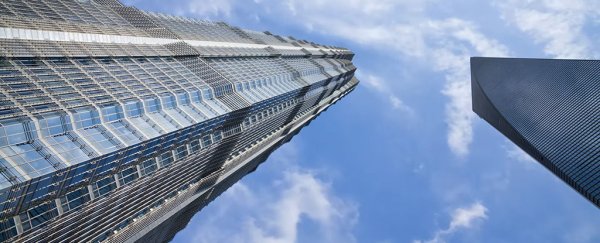If you're building a skyscraper, you've got a lot to think about, such as materials, aerodynamics, elevators, weather resistance, and safety features. The taller the building goes, the more complicated these issues usually get.
But despite the potential problems, skyscrapers are getting taller and taller - the world record for the tallest building has been broken three times in the past 20 years.
So how are engineers outdoing themselves over and over again? The Real Engineering video above explores one of the most important factors to consider; strong winds and building sway that can easily damage a super-tall structure if it's not properly designed.
As the video explains, once winds reach a certain speed, the flow of air around a skyscraper separates further from the surface of the building, and that creates pockets of air (or eddies) on the opposite side from the direction of the flow.
When these eddies become larger and stronger, they begin to oscillate, which interrupts the smooth flow of air and creates an effect called vortex shedding: the two symmetrical eddies behind the skyscraper are 'shed' alternately, so air rushes in to fill the void, creating oscillating air pressure rather than a steady flow.
The real problem starts when the frequency of the shedding matches the resonant frequency of the structure - the natural frequency at which the object (in our case, a building) vibrates.
When these two frequencies match, the building begins to sway, and if it hasn't been built properly, it could be enough to bring a structure down.
One common fix for this is dampening- building materials and frictions at the joints can be used to dampen or dissipate some of the build up of energy.
The Taipei 101 in Taiwan (the world's tallest building from 2004 to 2009) has a huge 730-metric tonne mechanical damper inside it, tuned it to the same resonance as the skyscraper itself, and designed to sway in direct opposition to the building itself and reduce its movement.
But the Burj Khalifa in Dubai, currently the world's tallest building, at 829.8 metres (2,722 feet) high, doesn't use a damper. Instead, it stops the vortices from ever forming in the first place.
As the video explains, some clever aerodynamics principles are involved. The cross-section of the building isn't uniform as you go up from floor to floor, so the air flow is disrupted, and the vortices or eddies can never get organised.
The successive tiers of the Burj Khalifa work like a kind of spiral, with the different arms of its Y-shaped base gradually getting shorter and shorter, one by one. Wind tunnel tests and computer models were used to make sure the skyscraper would never be in danger.
Our next record-breaker could be the Jeddah Tower, currently under-construction in Saudi Arabia. It's been designed to top out at 1,008 metres (3,307 feet), and will be the first skyscraper ever to break the 1 kilometre barrier.
There should be quite a view from the top, but watch out for the wind.
